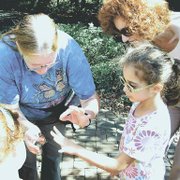Urban sprawl in Northern Virginia has driven away nature’s most fragile and beautiful creature, the butterfly. In the 1990s, only about 20 species were recorded in the area and populations were dwindling rapidly. Since then, at Meadowlark Gardens in Vienna, Keith Tomlinson’s vision for an ecologically diverse habitat has attracted over 30 additional species of native butterflies that were feared gone for good.
Tomlinson joined Meadowlark 10 years ago, with a background as an interpretive naturalist, and he manages the park’s collections. "My focus was to make an important transition in the nature collection to become more sophisticated and diverse," said Tomlinson. "This plant diversity promotes ecological stability, and the return of the butterflies has demonstrated this fact in an unexpected way."
Local geography and biology plays an important part in the garden’s layout. The Potomac River Valley garden is highly localized, which means that butterflies can find familiar host and nectar plants clustered together. "There is a long term evolutionary relationship between the butterflies and these plants," Tomlinson said. "Once they find these plants again, and there is relative safety from ravaging deer and predators, the butterflies will stay and multiply." Nectaring plants provide food and host plants are where butterflies lay their eggs.
RESIDENT PHOTOGRAPHER William Folsom has been taking pictures of butterflies at Meadowlark Gardens for as long as he can remember. Folsom authored a book on butterfly photography for shutterbugs and is currently working on "Butterflies of Meadowlark," a hardcover book that features photographs of the existing and reintroduced species of butterflies observed in the park. "I have been involved with this project since Keith joined and I enjoy going out to record and count butterflies. When the Potomac River Valley garden was being created, I observed a Dusky Wing female eagerly laying eggs in the flats that were waiting to be planted. The call of these native plants to the butterflies was unmistakable," Folsom said.
The Experimental Meadow was another ambitious project, where it took vision to leave a large area fallow and plant "weeds" that are butterfly host plants like Turtlehead for the rare Baltimore Checkerspot and Milkweed for the Monarch. Folsom pointed out that while these plants are not ornamental, they are real-time observatories for the sequence of life. "When the monarchs migrate here from Mexico, they lay their eggs on the milkweed plants. The leaves become lacy and curled up. When the milkweed is stripped bare, you know the caterpillars have survived and created another generation of beautiful butterflies," he said.
BREEDING BUTTERFLIES for release into the park is also a part of the Meadowlark program, supported by Herndon resident Mona Miller. "I got interested in butterflies about 16 years ago when my son’s teacher asked me to bring some butterflies out of my yard to his school. My extensive breeding program has allowed us to reintroduce and sustain populations in the park that would otherwise have difficulty taking hold," said Miller.
Since 2002, Miller has conducted a butterfly garden tour each summer Sunday from spring through fall. She starts the tour by showing visitors a butterfly chrysalis and a large caterpillar, along with eggs attached to the back of a leaf and tiny monarch caterpillars that had just emerged. Visitors can stroke the soft green caterpillar, which rears up for a closer look and leaves a small brown present on Miller’s palm.
Children are invited to participate in the release of butterflies into the park. Chloe Arana and her mother Heather came from Loudoun County to participate in the tour on a sunny and warm afternoon, the kind butterflies favor. Arana was fascinated by the colorful creature Miller placed in the palm of her hand. "It tickles," she giggled, while the butterfly paused briefly before taking flight into the sky.
Wending her way through the park, Miller stooped down to point out the even smallest specimens fluttering over the grass. The garden maintenance staff is acutely aware of how butterflies are affected by human activities. "By raising lawnmower blades and cutting the grass at least three inches high," said Miller, "we have preserved clover, which is the favorite nectaring plant for the Eastern Tail Blue."
Butterfly watching is definitely a sport to be done with children — they are much closer to the ground and more observant than most adults. Arana spotted monarch caterpillars on a milkweed plant in the Children’s Garden and a rare red Admiral on the hackberry tree by the pond. Miller caught a butterfly in her large net and put it in a jar for closer inspection. After several moments of captivity and rapt attention, the butterfly fluttered unharmed into the fragrant flowers of the garden.


